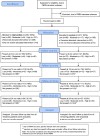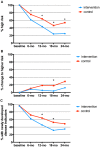Changes in Caries Risk in a Practice-Based Randomized Controlled Trial
- PMID: 29355409
- PMCID: PMC6699126
- DOI: 10.1177/0022034517737022
Changes in Caries Risk in a Practice-Based Randomized Controlled Trial
Abstract
To demonstrate that Caries Management by Risk Assessment (CAMBRA) can be successfully implemented in dental practice, 30 dentists were recruited to perform a 2-y CAMBRA trial. Twenty-one dentists (18 private practices, 3 community clinics) participated in a randomized, controlled, parallel-arm, double-blind clinical trial with individual-level assignment of 460 participants to standard of care (control) versus active CAMBRA treatment (intervention). Control or active antimicrobial and remineralizing agents were dispensed at baseline and 6-, 12-, 18-, and 24-mo recall visits according to risk level and assigned treatment arm. Primary outcome measure was dentist-determined caries risk level at recall. Among initially high-risk participants, secondary outcomes were recorded disease indicators. Generalized estimating equations were used to fit log-linear models for each outcome while accounting for repeated measurements. At 24 mo, follow-up rates were 34.3% for high-risk participants (32.1% intervention, 37.1% control) and 44.2% for low-risk participants (38.7% intervention, 49.5% control). Among 242 participants classified as high caries risk at baseline (137 intervention, 105 control), a lower percentage of participants remained at high risk in the intervention group (statistically significant at all time points). At 24 mo, 25% in the intervention group and 54% in the control group remained at high risk ( P = 0.003). Among 192 participants initially classified as low risk (93 intervention, 99 control), most participants remained at low risk. At 24 mo, 89% in the intervention group and 71% in the control group were low caries risk ( P = 0.18). The percentage of initially high-risk participants with recorded disease indicators decreased over time in both intervention and control groups, being always lower for the intervention group (statistically significant at the 12- and 18-mo time point). In this practice-based clinical trial, a significantly greater percentage of high-caries-risk participants were classified at a lower risk level after CAMBRA preventive therapies were provided. Most participants initially assessed at low caries risk stayed at low risk (ClinicalTrials.gov NCT01176396).
Keywords: Caries Management by Risk Assessment (CAMBRA); Practice-Based Research Network (PBRN); caries prevention; caries risk assessment; dental caries; disease indicators.
Conflict of interest statement
The authors declare no potential conflicts of interest with respect to the authorship and/or publication of this article.
Figures


References
-
- Doméjean S, Léger S, Maltrait M, Espelid I, Tveit AB, Tubert-Jeannin S. 2015. Changes in occlusal caries lesion management in France from 2002 to 2012: a persistent gap between evidence and clinical practice. Caries Res. 49(4):408–416. - PubMed
-
- Doméjean S, White JM, Featherstone JD. 2011. Validation of the CDA CAMBRA caries risk assessment—a six-year retrospective study. J Calif Dent Assoc. 39(10):709–715. - PubMed
-
- Doméjean-Orliaguet S, Gansky SA, Featherstone JD. 2006. Caries risk assessment in an educational environment. J Dent Educ. 70(12):1346–1354. - PubMed
-
- Featherstone JD. 2003. The caries balance: contributing factors and early detection. J Calif Dent Assoc. 31(2):129–133. - PubMed
Publication types
MeSH terms
Substances
Associated data
Grants and funding
LinkOut - more resources
Full Text Sources
Other Literature Sources
Medical

